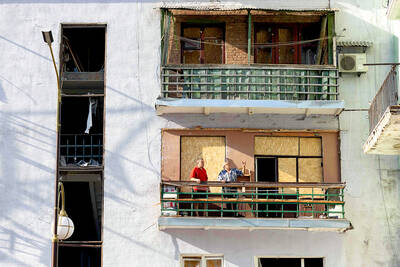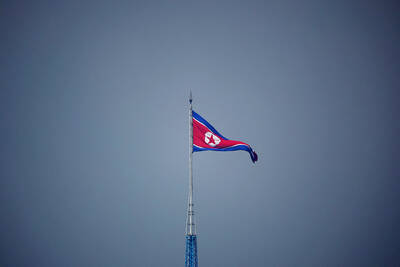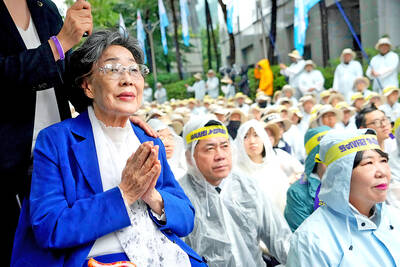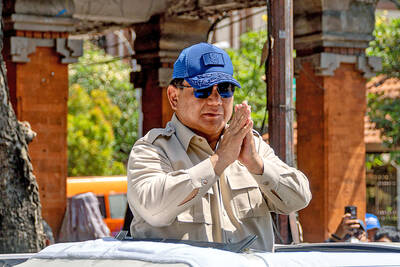Japanese company ispace said its uncrewed moon lander likely crashed onto the moon’s surface during its lunar touchdown attempt yesterday, marking another failure two years after its unsuccessful inaugural mission.
Tokyo-based ispace had hoped to join US firms Intuitive Machines and Firefly Aerospace as companies that have accomplished commercial landings amid a global race for the moon, which includes state-run missions from China and India. A successful mission would have made ispace the first company outside the US to achieve a moon landing.
Resilience, ispace’s second lunar lander, could not decelerate fast enough as it approached the moon, and the company has not been able to communicate with the spacecraft after a likely hard landing, ispace said in a statement.

Photo: AFP
The company’s livestream of the attempted landing showed Resilience’s flight data was lost less than two minutes before the planned touchdown time earlier yesterday.
The lander had targeted Mare Frigoris, a basaltic plain about 900km from the moon’s north pole, and was on an hour-long descent from lunar orbit.
A room of more than 500 ispace employees, shareholders, sponsors and government officials abruptly grew silent during a public viewing event at mission partner Sumitomo Mitsui Banking Corp in the wee hours in Tokyo.

Photo: AFP
Shares of ispace were untraded, overwhelmed by sell orders, and looked set to close at the daily limit-low, which would mark a 29 percent fall. As of the close of Thursday, ispace had a market capitalization of more than ¥110 billion (US$763.3 million).
In 2023, ispace’s first lander crashed into the moon’s surface due to inaccurate recognition of its altitude. Software remedies have been implemented, while the hardware design is mostly unchanged in Resilience, the company has said.
Resilience was carrying a four-wheeled rover built by ispace’s Luxembourg subsidiary and five external payloads worth a total of US$16 million, including scientific instruments from Japanese firms and Taiwan’s National Central University (NCU).
NCU contributed a Deep Space Radiation Probe as one of the scientific payloads aboard the lander.
If the landing had been successful, the 2.3m-high lander and the microwave-sized rover would have begun 14 days of planned exploration activities, including capturing images of regolith, the moon’s fine-grained surface material, on a contract with US space agency NASA.
Resilience in January shared a SpaceX rocket launch with Firefly’s Blue Ghost lander, which took a faster trajectory to the moon and touched down successfully in March.
Intuitive Machines, which last year marked the world’s first touchdown of a commercial lunar lander, made its second attempt in March, but the lander Athena ended up on its side, just as in the first mission.
Japan last year became the world’s fifth country to achieve a soft lunar landing after the former Soviet Union, the US, China and India, when the national Japan Aerospace Exploration Agency achieved the touchdown of its SLIM lander, although in a toppled position.
Despite US President Donald Trump’s proposed changes to the US space policy, Japan remains committed to the US-led Artemis moon program, pledging the involvement of Japanese astronauts and technologies for future lunar missions.
Including a third one in 2027 as part of NASA’s Commercial Lunar Payload Services for the Artemis program, ispace plans seven more missions in the US and Japan through 2029 to capture increasing demands for lunar transportation.
Additional reporting by staff writer

DEADLOCK: Putin has vowed to continue fighting unless Ukraine cedes more land, while talks have been paused with no immediate results expected, the Kremlin said Russia on Friday said that peace talks with Kyiv were on “pause” as Ukrainian President Volodymyr Zelenskiy warned that Russian President Vladimir Putin still wanted to capture the whole of Ukraine. Meanwhile, US President Donald Trump said that he was running out of patience with Putin, and the NATO alliance said it would bolster its eastern front after Russian drones were shot down in Polish airspace this week. The latest blow to faltering diplomacy came as Russia’s army staged major military drills with its key ally Belarus. Despite Trump forcing the warring sides to hold direct talks and hosting Putin in Alaska, there

North Korea has executed people for watching or distributing foreign television shows, including popular South Korean dramas, as part of an intensifying crackdown on personal freedoms, a UN human rights report said on Friday. Surveillance has grown more pervasive since 2014 with the help of new technologies, while punishments have become harsher — including the introduction of the death penalty for offences such as sharing foreign TV dramas, the report said. The curbs make North Korea the most restrictive country in the world, said the 14-page UN report, which was based on interviews with more than 300 witnesses and victims who had

COMFORT WOMEN CLASH: Japan has strongly rejected South Korean court rulings ordering the government to provide reparations to Korean victims of sexual slavery The Japanese government yesterday defended its stance on wartime sexual slavery and described South Korean court rulings ordering Japanese compensation as violations of international law, after UN investigators criticized Tokyo for failing to ensure truth-finding and reparations for the victims. In its own response to UN human rights rapporteurs, South Korea called on Japan to “squarely face up to our painful history” and cited how Tokyo’s refusal to comply with court orders have denied the victims payment. The statements underscored how the two Asian US allies still hold key differences on the issue, even as they pause their on-and-off disputes over historical

CONSOLIDATION: The Indonesian president has used the moment to replace figures from former president Jokowi’s tenure with loyal allies In removing Indonesia’s finance minister and U-turning on protester demands, the leader of Southeast Asia’s biggest economy is scrambling to restore public trust while seizing a chance to install loyalists after deadly riots last month, experts say. Demonstrations that were sparked by low wages, unemployment and anger over lawmakers’ lavish perks grew after footage spread of a paramilitary police vehicle running over a delivery motorcycle driver. The ensuing riots, which rights groups say left at least 10 dead and hundreds detained, were the biggest of Indonesian President Prabowo Subianto’s term, and the ex-general is now calling on the public to restore their